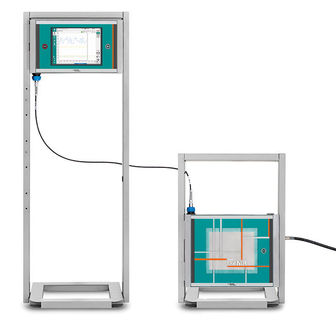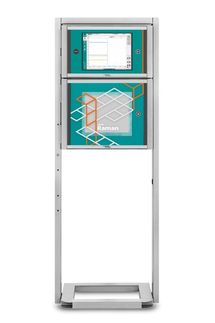Budd-Chiari syndrome
Classification & external resources
| ICD-10
| I82.0
|
| ICD-9
| 453.0
|
| OMIM
| 600880
|
| DiseasesDB
| 1735
|
| eMedicine
| med/2694 ped/296 radio/121
|
| MeSH
| D006502
|
In medicine (gastroenterology and hepatology), Budd-Chiari syndrome is the clinical picture caused by occlusion of the hepatic vein or inferior vena cava. Its presents with the classical triad of abdominal pain, ascites and hepatomegaly. Examples of occlusion include thrombosis of hepatic veins and membranous webs in the inferior vena cava. The syndrome can be fulminant, acute, chronic, or asymptomatic. It occurs in 1 out of 100,000 individuals and is more common in females. Some 10-20% also have obstruction of the portal vein.
Signs and symptoms
The acute syndrome presents with rapidly progressive: severe upper abdominal pain, jaundice, hepatomegaly (enlarged liver), ascites, elevated liver enzymes, and eventual encephalopathy. The fulminant syndrome presents early with encephalopathy and ascites. Severe hepatic necrosis and lactic acidosis may be present as well. Caudate lobe hypertrophy is often present. The majority of patients have a slower-onset form of Budd-Chiari syndrome. This can be painless. A system of venous collaterals may form around the occlusion which may be seen on imaging as a "spider's web." Patients may progress to cirrhosis and show the signs of liver failure.
An asymptomatic form may be totally silent and discovered only incidentally. It is generally not concerning.
Causes
- The cause cannot be found in about half of the patients
- Primary (75%): thrombosis of the hepatic vein
- Secondary (25%): compression of the hepatic vein by an outside structure (e.g. a tumor)
- Pregnancy and oral contraceptive use
- Congenital venous webs
- Occationally inferior vena caval stenosis
Often, the patient is known to have a tendency towards thrombosis, although Budd-Chiari syndrome can also be the first symptom of such a tendency. Examples of genetic tendencies include Protein C deficiency, Protein S deficiency, and the Factor V Leiden mutation. An important non-genetic risk factor is the use of estrogen-containing (combined) forms of hormonal contraception. Other risk factors include the antiphospholipid syndrome, aspergillosis, Behcet's disease, dacarbazine, pregnancy, and trauma.
Many patients have Budd-Chiari syndrome as a complication of polycythemia vera (myeloproliferative disease of red blood cells). [1] Patients suffering from paroxysmal nocturnal hemoglobinuria (PNH) appear to be especially at risk for Budd-Chiari syndrome, more than other forms of thrombophilia: up to 39% develop venous thromboses [2] and 12% may acquire Budd-Chiari. [3]
A related condition is veno-occlusive disease, which occurs in recipients of bone marrow transplants as a complication of their medication. Although its mechanism is similar, it is not considered a form of Budd-Chiari syndrome.
Pathophysiology
Any obstruction of the venous vasculature of the liver is referred to as Budd-Chiari syndrome, from the venules to the right atrium. This leads to increased portal vein and hepatic sinusoid pressures as the blood flow stagnates. The increased portal pressure causes: 1) increased filtration of vascular fluid with the formation of protein-rich ascites in the abdomen; and 2) collateral venous flow through alternative veins leading to gastric varices and hemorrhoids. Obstruction also causes hepatic necrosis and eventual centrilobular fibrosis due to ischemia. Renal failure may occur, perhaps due to the body sensing an "underfill" state and subsequent activation of the renin-angiotensin pathways and excess sodium retention.
Diagnosis
When Budd-Chiari syndrome is suspected, measurements are made of liver enzyme levels and other organ markers (creatinine, urea, electrolytes, LDH).
Budd-Chiari syndrome is most commonly diagnosed using ultrasound studies of the abdomen and retrograde angiography). Ultrasound may show obliteration of hepatic veins, thrombosis or stenosis, spiderweb vessels, large collateral vessels, or a hyperechoic cord replacing a normal vein. Computed tomography (CT) or magnetic resonance imaging (MRI) is sometimes employed although these methods are generally not as sensitive. Liver biopsy is nonspecific but sometimes necessary to differentiate between Budd-Chiari syndrome and other causes of hepatomegaly and ascites, such as galactosemia or Reye's syndrome.
Prognosis
Several studies have attempted to predict the survival of patients with Budd-Chiari syndrome. In general, nearly 2/3 of patients with Budd-Chiari survive 10 years. [4] Important negative prognostic indicators include ascites, encephalopathy, elevated Child-Pugh scores, elevated prothrombin time, and altered serum levels of various substances (sodium, creatinine, albumin, and bilirubin). Survival is also highly dependent on the underlying cause of the Budd-Chiari syndrome. For example, patients with myeloproliferative disorders may progress to acute leukemia despite treatment for Budd-Chiari syndrome.
Treatment
A minority of patients can be treated medically with sodium restriction, diuretics to control ascites, anticoagulants such as heparin and warfarin, and general symptomatic management. The majority of patients require further intervention. Milder forms of Budd-Chiari may be treated with surgical shunts to divert blood flow around the obstruction or the liver itself. Shunts must be placed early after diagnosis for best results. [4] The transjugular intrahepatic portosystemic shunt (TIPS) is similar to a surgical shunt. It accomplishes the same goal but has a lower procedure-related mortality, which has led to a growth in its popularity. Patients with stenosis or vena caval obstruction may benefit from angioplasty. [5] Limited studies on thrombolysis with direct infusion of urokinase and tissue plasminogen activator (tPA) into the obstructed vein have shown moderate success in treating Budd-Chiari syndrome; however, it is not routinely attempted.
Liver transplantation is an effective treatment for Budd-Chiari. It is generally reserved for patients with fulminant hepatic failure, failure of shunts, or progression of cirrhosis that reduces the life expectancy to 1 year. [6] Long-term survival after transplantation ranges from 69-87%. The most common complications of transplant include rejection, arterial or venous thromboses, and bleeding due to anticoagulation. Up to 10% of patients may have a recurrence of Budd-Chiari syndrome after the transplant.
Eponym
It is named for George Budd[7][8] and Hans Chiari.[9]
References
- ^ Patel RK, Lea NC, Heneghan MA, Westwood NB, Milojkovic D, Thanigaikumar M, Yallop D, Arya R, Pagliuca A, Gaken J, Wendon J, Heaton ND, Mufti GJ. Prevalence of the activating JAK2 tyrosine kinase mutation V617F in the Budd-Chiari syndrome. Gastroenterology. 2006 Jun;130(7):2031-8.
- ^ Hillmen P, Lewis SM, Bessler M, Luzzatto L, Dacie JV. Natural history of paroxysmal nocturnal hemoglobinuria. N Engl J Med. 1995 Nov 9;333(19):1253-8.
- ^ Socie G, Mary JY, de Gramont A, Rio B, Leporrier M, Rose C, Heudier P, Rochant H, Cahn JY, Gluckman E. Paroxysmal nocturnal haemoglobinuria: long-term follow-up and prognostic factors. French Society of Haematology. Lancet. 1996 Aug 31;348(9027):573-7.
- ^ a b Murad SD, Valla DC, de Groen PC, Zeitoun G, Hopmans JA, Haagsma EB, van Hoek B, Hansen BE, Rosendaal FR, Janssen HL Determinants of survival and the effect of portosystemic shunting in patients with Budd-Chiari syndrome. Hepatology. 2004 Feb;39(2):500-8.
- ^ Fisher NC, McCafferty I, Dolapci M, Wali M, Buckels JA, Olliff SP, Elias E. Managing Budd-Chiari syndrome: a retrospective review of percutaneous hepatic vein angioplasty and surgical shunting. Gut. 1999 Apr;44(4):568-74.
- ^ Orloff MJ, Daily PO, Orloff SL, Girard B, Orloff MS. A 27-year experience with surgical treatment of Budd-Chiari syndrome. Ann Surg. 2000 Sep;232(3):340-52.
- ^ synd/1335 at Who Named It
- ^ G. Budd. On diseases of the liver. London, J. Churchill, 1845. Page 135.
- ^ H. Chiari. Erfahrungen über Infarktbildungen in der Leber des Menschen. Zeitschrift für Heilkunde, Prague, 1898, 19: 475-512.
| Digestive system - Gastroenterology (primarily K20-K93, 530-579) |
|---|
| Esophagus | Esophagitis - GERD - Achalasia - Boerhaave syndrome - Nutcracker esophagus - Zenker's diverticulum - Mallory-Weiss syndrome - Barrett's esophagus |
|---|
Stomach/
duodenum | Peptic (gastric/duodenal) ulcer - Gastritis - Gastroenteritis - Duodenitis - Dyspepsia - Pyloric stenosis - Achlorhydria - Gastroparesis - Gastroptosis - Portal hypertensive gastropathy |
|---|
| Hernia | Inguinal (Indirect, Direct) - Femoral - Umbilical - Incisional - Diaphragmatic - Hiatus |
|---|
| Noninfective enteritis and colitis | IBD (Crohn's, Ulcerative colitis) - noninfective gastroenteritis |
|---|
| Other intestinal | vascular (Abdominal angina, Mesenteric ischemia, Ischemic colitis, Angiodysplasia) - Ileus/Bowel obstruction (Intussusception, Volvulus) - Diverticulitis/Diverticulosis - IBS
other functional intestinal disorders (Constipation, Diarrhea, Megacolon/Toxic megacolon, Proctalgia fugax) - Anal fissure/Anal fistula - Anal abscess - Rectal prolapse - Proctitis (Radiation proctitis) |
|---|
| Liver/hepatitis | Alcoholic liver disease - Liver failure (Acute liver failure) - Cirrhosis - PBC - NASH - Fatty liver - Peliosis hepatis - Portal hypertension - Hepatorenal syndrome |
|---|
| Accessory digestive | Gallbladder (Gallstones, Choledocholithiasis, Cholecystitis, Cholesterolosis, Rokitansky-Aschoff sinuses)
Biliary tree (Cholangitis, Cholestasis/Mirizzi's syndrome, PSC, Biliary fistula, Ascending cholangitis)
Pancreas (Acute pancreatitis, Chronic pancreatitis, Pancreatic pseudocyst, Hereditary pancreatitis) |
|---|
| Other/general | Appendicitis - Peritonitis (Spontaneous bacterial peritonitis)
Malabsorption (celiac, Tropical sprue, Blind loop syndrome, Whipple's)
postprocedural: Gastric dumping syndrome - Postcholecystectomy syndrome
bleeding: Hematemesis - Melena - Gastrointestinal bleeding (Upper, Lower) |
|---|
| See also congenital |
| Circulatory system pathology (I, 390-459) |
|---|
| Hypertension | Hypertensive heart disease - Hypertensive nephropathy - Secondary hypertension (Renovascular hypertension) |
|---|
| Ischaemic heart disease | Angina pectoris (Prinzmetal's angina) - Myocardial infarction - Dressler's syndrome |
|---|
| Pulmonary circulation | Pulmonary embolism - Cor pulmonale |
|---|
| Pericardium | Pericarditis - Pericardial effusion - Cardiac tamponade |
|---|
| Endocardium/heart valves | Endocarditis - mitral valves (regurgitation, prolapse, stenosis) - aortic valves (stenosis, insufficiency) - pulmonary valves (stenosis, insufficiency) - tricuspid valves (stenosis, insufficiency) |
|---|
| Myocardium | Myocarditis - Cardiomyopathy (Dilated cardiomyopathy, Hypertrophic cardiomyopathy, Loeffler endocarditis, Restrictive cardiomyopathy) - Arrhythmogenic right ventricular dysplasia |
|---|
Electrical conduction system
of the heart | Heart block: AV block (First degree, Second degree, Third degree) - Bundle branch block (Left, Right) - Bifascicular block - Trifascicular block
Pre-excitation syndrome (Wolff-Parkinson-White, Lown-Ganong-Levine) - Long QT syndrome - Adams-Stokes syndrome - Cardiac arrest - Sudden cardiac death
Arrhythmia: Paroxysmal tachycardia (Supraventricular, AV nodal reentrant, Ventricular) - Atrial flutter - Atrial fibrillation - Ventricular fibrillation - Premature contraction (Atrial, Ventricular) - Ectopic pacemaker - Sick sinus syndrome |
|---|
| Other heart conditions | Heart failure - Cardiovascular disease - Cardiomegaly - Ventricular hypertrophy (Left, Right) |
|---|
| Cerebrovascular diseases | Intracranial hemorrhage/cerebral hemorrhage: Extra-axial hemorrhage (Epidural hemorrhage, Subdural hemorrhage, Subarachnoid hemorrhage)
Intra-axial hematoma (Intraventricular hemorrhages, Intraparenchymal hemorrhage) - Anterior spinal artery syndrome - Binswanger's disease - Moyamoya disease |
|---|
Arteries, arterioles
and capillaries | Atherosclerosis (Renal artery stenosis) - Aortic dissection/Aortic aneurysm (Abdominal aortic aneurysm) - Aneurysm - Raynaud's phenomenon/Raynaud's disease - Buerger's disease - Vasculitis/Arteritis (Aortitis) - Intermittent claudication - Arteriovenous fistula - Hereditary hemorrhagic telangiectasia - Spider angioma |
|---|
Veins, lymphatic vessels
and lymph nodes | Thrombosis/Phlebitis/Thrombophlebitis (Deep vein thrombosis, May-Thurner syndrome, Portal vein thrombosis, Venous thrombosis, Budd-Chiari syndrome, Renal vein thrombosis, Paget-Schroetter disease) - Varicose veins / Portacaval anastomosis (Hemorrhoid, Esophageal varices, Varicocele, Gastric varices, Caput medusae) - Superior vena cava syndrome - Lymph (Lymphadenitis, Lymphedema, Lymphangitis) |
|---|
| Other | Hypotension (Orthostatic hypotension) |
|---|
| See also congenital (Q20-Q28, 745-747) |
|







